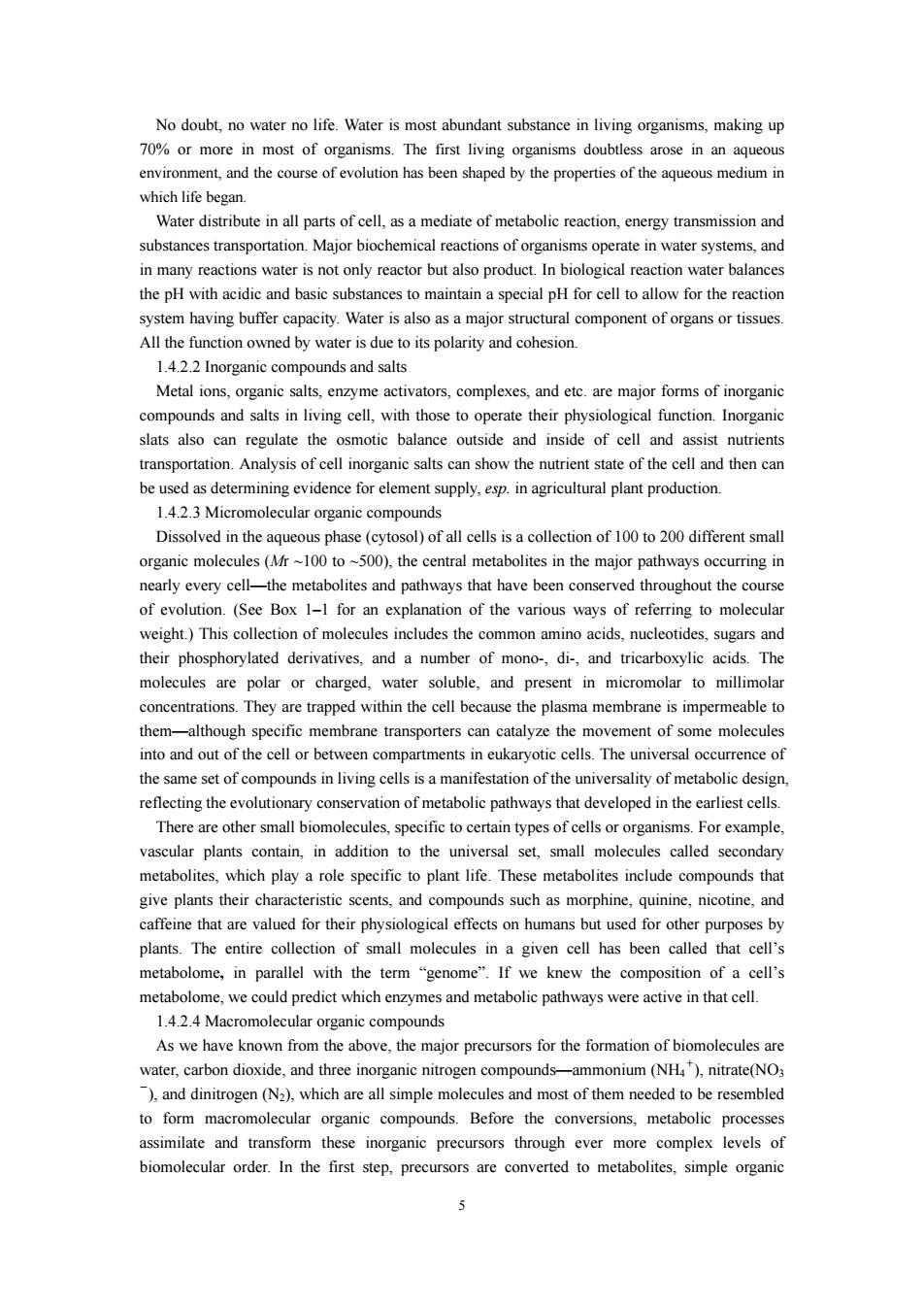
No doubt,no water no life.Water is most abundant substance in living organisms,making up %or more 学nD in aqueous medium in which life began Water distribute in all parts of cell.as a mediate of metabolic reaction.energy transmission and substances transportation.Major biochemical reactions of organisms operate in water systems.and in many reactions water is not only reactor but also product.In biological reaction water balances the pH with acidic and basic sub stances to maintain a special pH for cell to allow for the r eact system having buffer capacity.Water is also as a major structural component of organs or tissues All the function owned by water is due to its polarity and cohesion. 1.4.2.2 Inorganic compounds and salts Metal ions.organic salts.enzyme activators complexes and etc are maior forms of inorganic eompounds and salts in living cell,with reulate the osmotic balance outside and inside and assist nutrient transportation.Analysis of cell inorganic salts can show the nutrient state of the cell and then can be used as determining evidence for element supply,esp.in agricultural plant production. 1.4.2.3 Micromolecular organic compounds Dissolved in theaqueous phase (cytosol)of all cells of small organic molecules(M 100 to 50)the in the major nearly every cel the metabolites and pathways that have been conserved throughout the course of evolution.(See Box 1-1 for an explanation of the various ways of referring to molecular weight This collection of molecules includes the common amino acids,nucleotides,sugars and their phosphorylated derivatives,and a number of,and tricarboxylic acids.The polar or charged. present in micromolar concentrations.They are trapped within the cell because the plasma membrane is impermeable to them-although specific membrane transporters can catalyze the movement of some molecules into and out of the cell or between compartments in eukarvotic cells.The universal occurrence of the same set of compounds in living cells is a manifestation of the universality of metabolic design vation of metabolic pathways that developed in the earliest cell There ar eother small tocertain types of celsor For exampl vascular plants contain,in addition to the universal set,small molecules called secondary metabolites.which play a role specific to plant life.These metabolites include compounds that give plants their characteristic scents,and compounds such as morphine,quinine,nicotine,and caffeine that are valuedfor their physiological humans but used for other purposes by plants.The entire olle olecules in a given cell as been called metabolome,in parallel with the term "genome".If we knew the composition of a cell's metabolome.we could predict which enzymes and metabolic pathways were active in that cell 1.4.2.4 Macromolecular organic compounds As we have known from the above,the major precursors for the formation of biomolecules are monium (NH).nitrate(NO and dinitrogen(N)which areall simple molecules and most of them needed tobe resembe to form macromolecular organic compounds.Before the conversions,metabolic processes assimilate and transform these inorganic precursors through ever more complex levels of biomolecular order.In the first step,precursors are converted to metabolites,simple organic 5
5 No doubt, no water no life. Water is most abundant substance in living organisms, making up 70% or more in most of organisms. The first living organisms doubtless arose in an aqueous environment, and the course of evolution has been shaped by the properties of the aqueous medium in which life began. Water distribute in all parts of cell, as a mediate of metabolic reaction, energy transmission and substances transportation. Major biochemical reactions of organisms operate in water systems, and in many reactions water is not only reactor but also product. In biological reaction water balances the pH with acidic and basic substances to maintain a special pH for cell to allow for the reaction system having buffer capacity. Water is also as a major structural component of organs or tissues. All the function owned by water is due to its polarity and cohesion. 1.4.2.2 Inorganic compounds and salts Metal ions, organic salts, enzyme activators, complexes, and etc. are major forms of inorganic compounds and salts in living cell, with those to operate their physiological function. Inorganic slats also can regulate the osmotic balance outside and inside of cell and assist nutrients transportation. Analysis of cell inorganic salts can show the nutrient state of the cell and then can be used as determining evidence for element supply, esp. in agricultural plant production. 1.4.2.3 Micromolecular organic compounds Dissolved in the aqueous phase (cytosol) of all cells is a collection of 100 to 200 different small organic molecules (Mr ~100 to ~500), the central metabolites in the major pathways occurring in nearly every cell—the metabolites and pathways that have been conserved throughout the course of evolution. (See Box 1–1 for an explanation of the various ways of referring to molecular weight.) This collection of molecules includes the common amino acids, nucleotides, sugars and their phosphorylated derivatives, and a number of mono-, di-, and tricarboxylic acids. The molecules are polar or charged, water soluble, and present in micromolar to millimolar concentrations. They are trapped within the cell because the plasma membrane is impermeable to them—although specific membrane transporters can catalyze the movement of some molecules into and out of the cell or between compartments in eukaryotic cells. The universal occurrence of the same set of compounds in living cells is a manifestation of the universality of metabolic design, reflecting the evolutionary conservation of metabolic pathways that developed in the earliest cells. There are other small biomolecules, specific to certain types of cells or organisms. For example, vascular plants contain, in addition to the universal set, small molecules called secondary metabolites, which play a role specific to plant life. These metabolites include compounds that give plants their characteristic scents, and compounds such as morphine, quinine, nicotine, and caffeine that are valued for their physiological effects on humans but used for other purposes by plants. The entire collection of small molecules in a given cell has been called that cell’s metabolome, in parallel with the term “genome”. If we knew the composition of a cell’s metabolome, we could predict which enzymes and metabolic pathways were active in that cell. 1.4.2.4 Macromolecular organic compounds As we have known from the above, the major precursors for the formation of biomolecules are water, carbon dioxide, and three inorganic nitrogen compounds—ammonium (NH4 +), nitrate(NO3 - ), and dinitrogen (N2), which are all simple molecules and most of them needed to be resembled to form macromolecular organic compounds. Before the conversions, metabolic processes assimilate and transform these inorganic precursors through ever more complex levels of biomolecular order. In the first step, precursors are converted to metabolites, simple organic
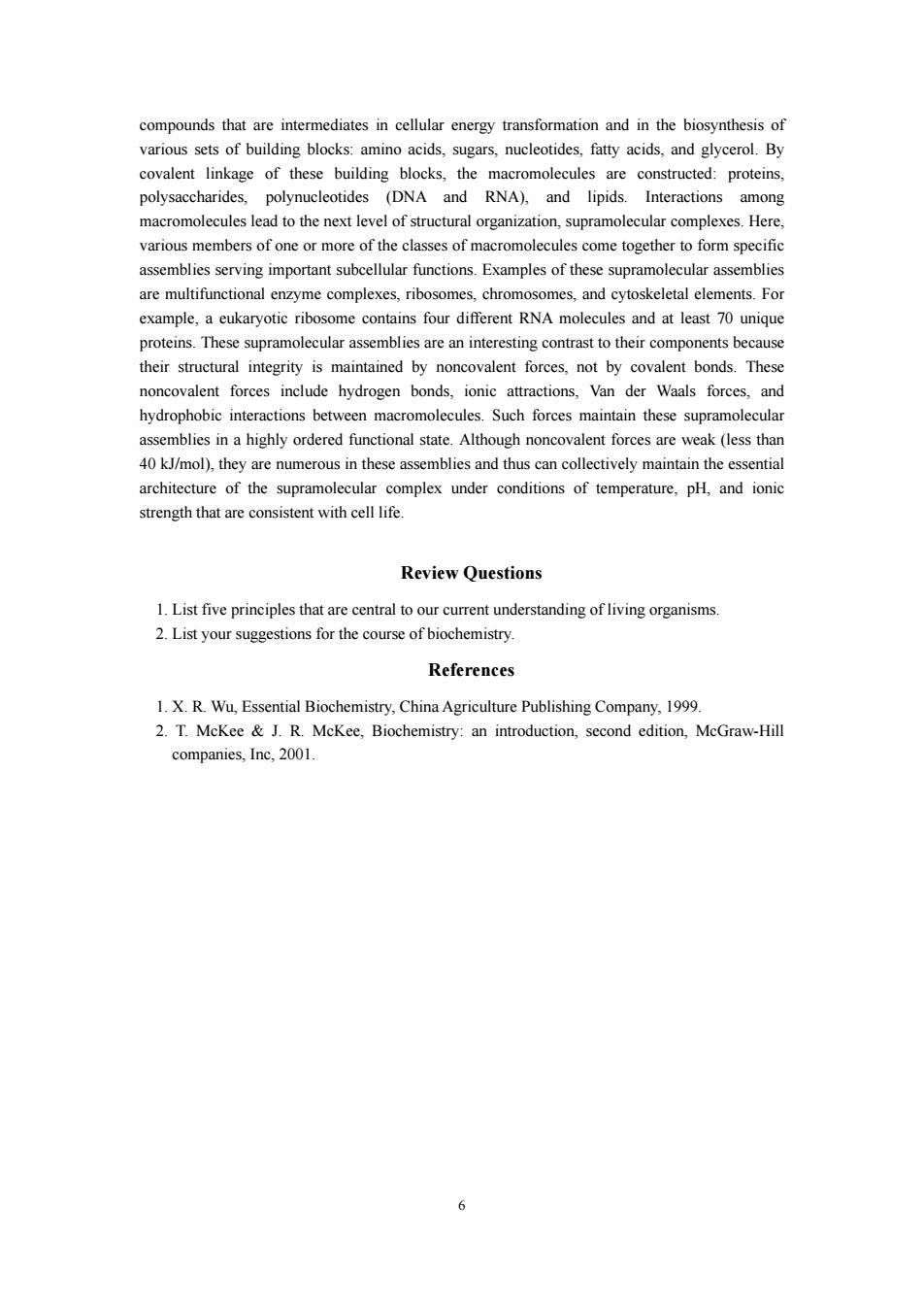
compounds that are intermediates in cellular energy transformation and in the biosynthesis of various sets of building blocks amino acids,sugars,nucleotides,fatty acids,and glycerol.By covalent linkage of these blocks.th re constructed:proteins polysaccharides,polynucleotides (DNA and RNA),and lipids Interactions among macromolecules lead to the next level of structural organization,supramolecular complexes.Here, various members of one or more of the classes of macromolecules come together to form specific assemblies serving important subcellular functions.Examples of these supramolecular assemblies aremultifunction zyme complexes,ribosomes,chro es,and cytoskeletal elements.For exampe,a ukaryotic ibsome four RNA molecules and at least7 uniqu proteins.These supramolecular assemblies are an interesting contrast to their components because their structural integrity is maintained by noncovalent forces,not by covalent bonds.These noncovalent forces include hydrogen bonds.ionic attractions.Van der Waals forces.and hydrophobic interactions between macromolecules.Such forces maintain these supramolecular ovaent forces are weak (essth architecture of the supramolecular complex under conditions of temperature,pH,and ionic strength that are consistent with cell life. Review Questions 1.List five principles that are central to our current understanding of living organisms. 2.List your suggestions for the course of biochemistry. References 1.X.R.Wu,Essential Biochemistry,China Agriculture Publishing Company,1999 2.T.MeKee J.R.MeKee,Biochemistry:an introduction,second edition,MeGraw-Hill companies,Inc,2001. 6
6 compounds that are intermediates in cellular energy transformation and in the biosynthesis of various sets of building blocks: amino acids, sugars, nucleotides, fatty acids, and glycerol. By covalent linkage of these building blocks, the macromolecules are constructed: proteins, polysaccharides, polynucleotides (DNA and RNA), and lipids. Interactions among macromolecules lead to the next level of structural organization, supramolecular complexes. Here, various members of one or more of the classes of macromolecules come together to form specific assemblies serving important subcellular functions. Examples of these supramolecular assemblies are multifunctional enzyme complexes, ribosomes, chromosomes, and cytoskeletal elements. For example, a eukaryotic ribosome contains four different RNA molecules and at least 70 unique proteins. These supramolecular assemblies are an interesting contrast to their components because their structural integrity is maintained by noncovalent forces, not by covalent bonds. These noncovalent forces include hydrogen bonds, ionic attractions, Van der Waals forces, and hydrophobic interactions between macromolecules. Such forces maintain these supramolecular assemblies in a highly ordered functional state. Although noncovalent forces are weak (less than 40 kJ/mol), they are numerous in these assemblies and thus can collectively maintain the essential architecture of the supramolecular complex under conditions of temperature, pH, and ionic strength that are consistent with cell life. Review Questions 1. List five principles that are central to our current understanding of living organisms. 2. List your suggestions for the course of biochemistry. References 1. X. R. Wu, Essential Biochemistry, China Agriculture Publishing Company, 1999. 2. T. McKee & J. R. McKee, Biochemistry: an introduction, second edition, McGraw-Hill companies, Inc, 2001
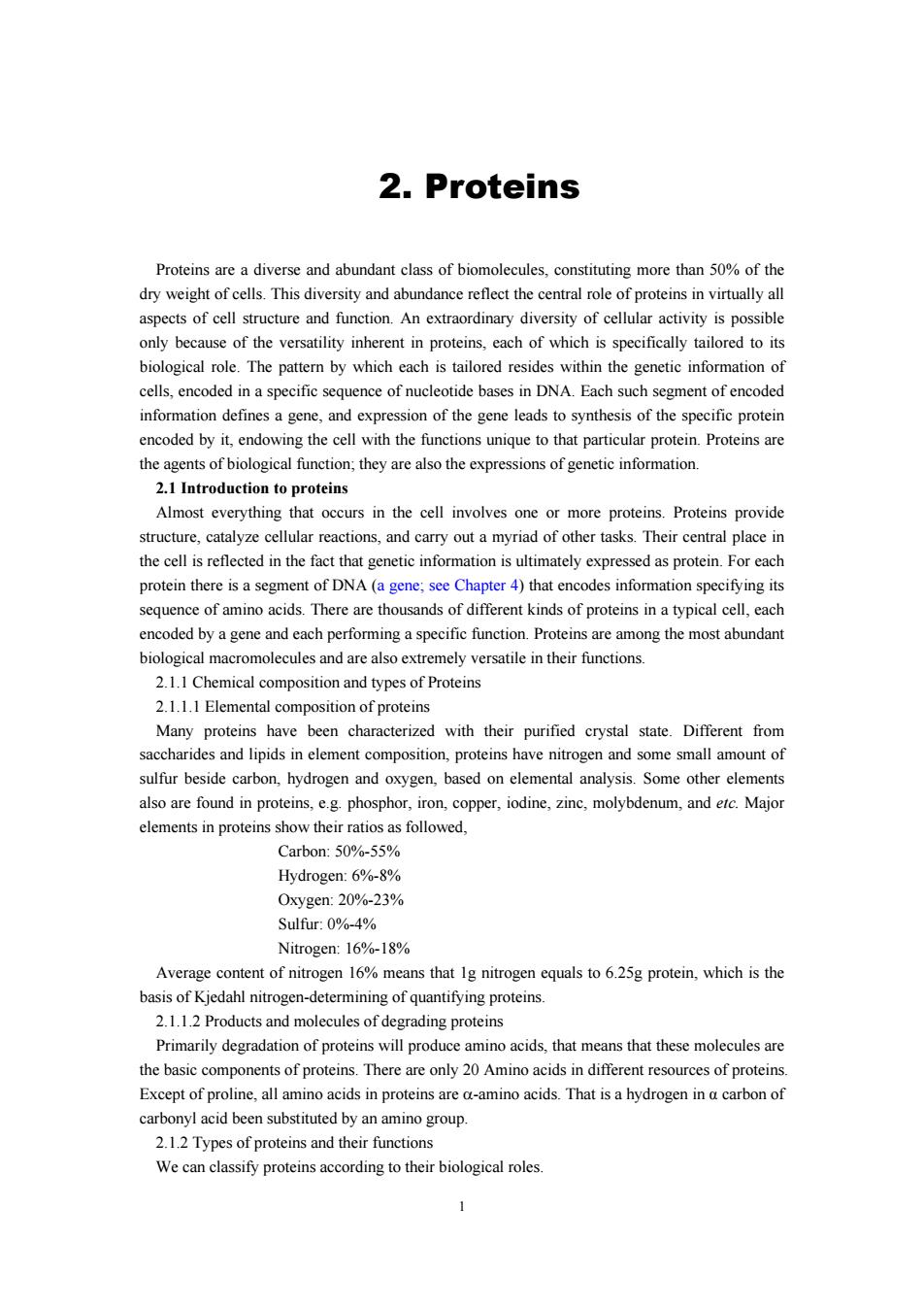
2.Proteins Proteins are a diverse and abundant class of biomolecules,constituting more than 50%of the dryweigh of cls.This diversity and of proteins aspects of cell structure and function.An extraordinary diversity of cellular activity is possibl only because of the versatility inherent in proteins,each of which is specifically tailored to its biological role.The pattern by which each is tailored resides within the genetic information of cells,encoded in a specific sequence of nucleotide bases in DNA.Each such segment of encoded ression of the gene leads to synthesis of th enoded by the cell with the functions to that particular protein Proteins are the agents of biological function;they are also the expressions of genetic information. 2.1 Introduetion to proteins Almost everything that occurs in the cell involves one or more proteins.Proteins provide ,cataye celar reactions,and myriad of other tasks.Their cen place in protein there is a segment of DNA (a gene;see Chapter 4)that encodes information specifying its sequence of amino acids.There are thousands of different kinds of proteins in a typical cell each encoded by a gene and each performing a specific function.Proteins are among the most abundant biological macromolecules and are also extremely versatile in their functions 2.11.1 Elemental composition of proteins Many proteins have been characterized with their purified crystal state.Different from saccharides and lipids in element composition,proteins have nitrogen and some small amount of sulfur beside carbon,hydrogen and oxygen,based on elemental analysis.Some other elements alsoare found in proteins,phosphor iron,copper,iodine,zinc,molybdenum,and er Major Carbon:50%-55% Hydrogen:6%-8% 0ygen:20%-23% Sulfur:0%-4% Nitrogen:16%-18% Average content of nitrogen 16%means that 1g nitrogen equals to 6.25g protein,which is the basis of Kjedahl nitrogen-determining of quantifying proteins. 2.1.1.2 Products and molecules of degrading proteins Primarily degradation of proteins will produce amino acids.that means that these molecules are the basic comp nents of proteins.There are ony acids in different resoures of proteins Except of in proteins acids That isa hydrogen of carbonyl acid been substituted by an amino group. 2.1.2 Types of proteins and their functions We can classify proteins according to their biological roles
1 2. Proteins Proteins are a diverse and abundant class of biomolecules, constituting more than 50% of the dry weight of cells. This diversity and abundance reflect the central role of proteins in virtually all aspects of cell structure and function. An extraordinary diversity of cellular activity is possible only because of the versatility inherent in proteins, each of which is specifically tailored to its biological role. The pattern by which each is tailored resides within the genetic information of cells, encoded in a specific sequence of nucleotide bases in DNA. Each such segment of encoded information defines a gene, and expression of the gene leads to synthesis of the specific protein encoded by it, endowing the cell with the functions unique to that particular protein. Proteins are the agents of biological function; they are also the expressions of genetic information. 2.1 Introduction to proteins Almost everything that occurs in the cell involves one or more proteins. Proteins provide structure, catalyze cellular reactions, and carry out a myriad of other tasks. Their central place in the cell is reflected in the fact that genetic information is ultimately expressed as protein. For each protein there is a segment of DNA (a gene; see Chapter 4) that encodes information specifying its sequence of amino acids. There are thousands of different kinds of proteins in a typical cell, each encoded by a gene and each performing a specific function. Proteins are among the most abundant biological macromolecules and are also extremely versatile in their functions. 2.1.1 Chemical composition and types of Proteins 2.1.1.1 Elemental composition of proteins Many proteins have been characterized with their purified crystal state. Different from saccharides and lipids in element composition, proteins have nitrogen and some small amount of sulfur beside carbon, hydrogen and oxygen, based on elemental analysis. Some other elements also are found in proteins, e.g. phosphor, iron, copper, iodine, zinc, molybdenum, and etc. Major elements in proteins show their ratios as followed, Carbon: 50%-55% Hydrogen: 6%-8% Oxygen: 20%-23% Sulfur: 0%-4% Nitrogen: 16%-18% Average content of nitrogen 16% means that 1g nitrogen equals to 6.25g protein, which is the basis of Kjedahl nitrogen-determining of quantifying proteins. 2.1.1.2 Products and molecules of degrading proteins Primarily degradation of proteins will produce amino acids, that means that these molecules are the basic components of proteins. There are only 20 Amino acids in different resources of proteins. Except of proline, all amino acids in proteins are α-amino acids. That is a hydrogen in α carbon of carbonyl acid been substituted by an amino group. 2.1.2 Types of proteins and their functions We can classify proteins according to their biological roles
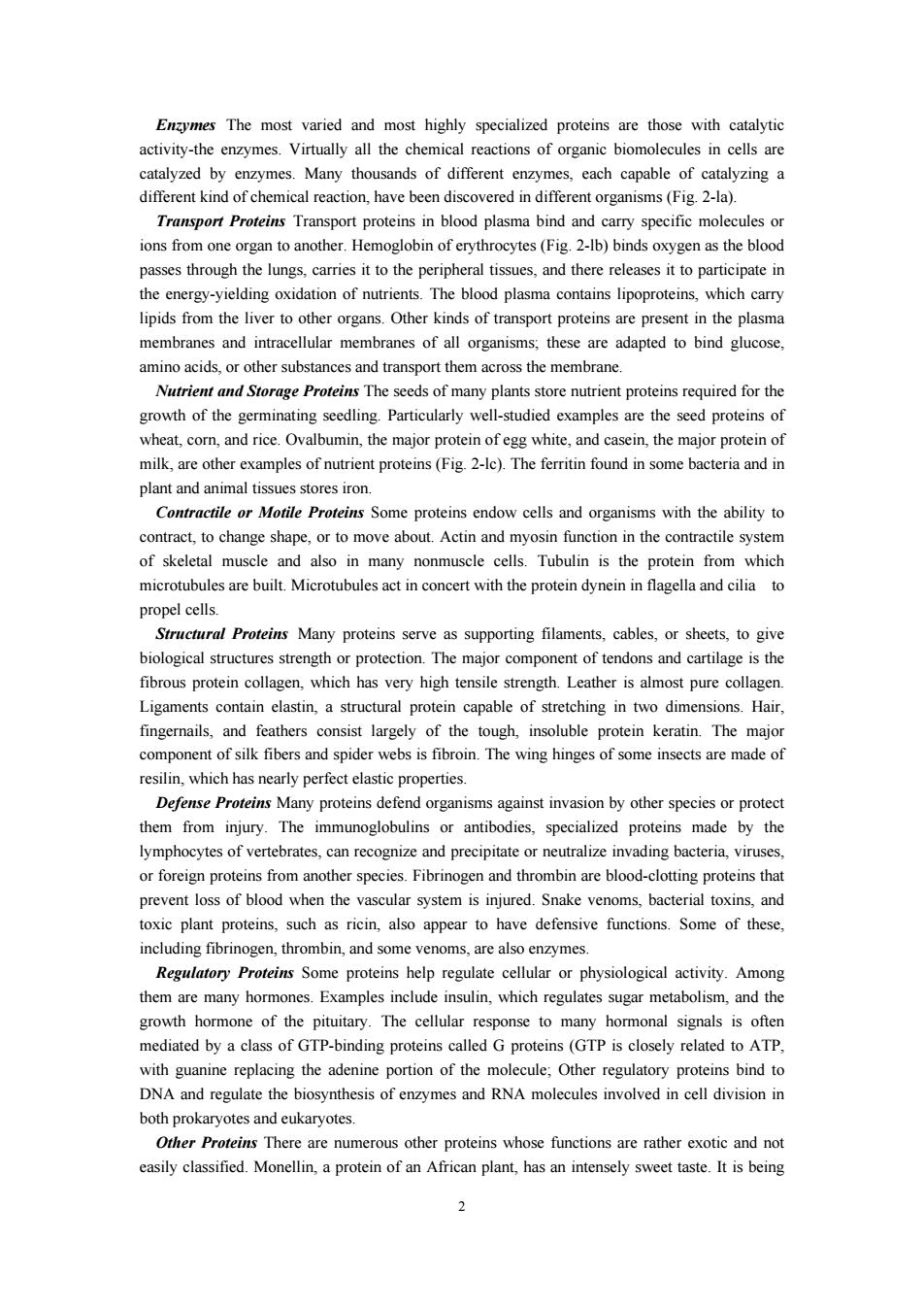
Enzymes The most varied and most highly specialized proteins are those with catalytic activity-the enzymes.Virtually all the chemical reactions of organic biomolecules in cells are eatalyzed by enzyme Many the ands of different enzymes,each capableo catalyzing a Transport Proteins Transport proteins in blood plasma bind and carry specific molecules or ions from one organ to another.Hemoglobin of erythrocytes(Fig.2-lb)binds oxygen as the blood passes through the lungs.carries it to the peripheral tissues.and there releases it to participate in theenergy-yiedingxition of rient.Theblod plasma contains lipoproteins,which carry lipids from the organs.Other kinds of transport proteins are present in the plasm membranes and intracellular membranes of all organisms;these are adapted to bind glucose. amino acids.or other substances and transport them across the membrane. Nutrient and Storage Proteins The seeds of many plants store nutrient proteins required for the owth of the germinating seeding Particularly well-studied examples are theseedo min themajor protein the major protei milk,are other examples of nutrient proteins (Fig.2-lc).The ferritin found in some bacteria and ir plant and animal tissues stores iron. Contractile or Motile Proteins Some proteins endow cells and organisms with the ability to ochangto move abo Actin andyhe onractle te of skeletal muscle and also in man nonmuscle protein from which microtubulesare but Microtubules act the protein dynein in ato propel cells. Structural Proteins Many proteins serve as supporting filaments,cables,or sheets,to give biological structures strength or protection.The major component of tendons and cartilage is the fibrous protein which has very high tensile streng th.Leather is amost pure collager Ligaments contair lastin,a structural protein capable of stretching in two dimensions.Hai fingernails,and feathers consist largely of the tough,insoluble protein keratin.The major component of silk fibers and spider webs is fibroin.The wing hinges of some insects are made of resilin,which has nearly perfect elastic properties. Defense Proteins Many proteins defend organisms against invasion by other species or protect them from injury The or antiboc specialized protei nade by the lymphocytes of vertebrates,can recognize and precipitate or neutralize invading bacteria,viruses or foreign proteins from another species.Fibrinogen and thrombin are blood-clotting proteins that prevent loss of blood when the vascular system is injured.Snake venoms,bacterial toxins,and toxic plant proteins.such as ricin,also appear to have defensive functions.Some of these. gen,thrombin,and som noms,are also en ymes Proteins Some proteins help regulate cellular or physiological activity.Among them are many hormones.Examples include insulin,which regulates sugar metabolism,and the growth hormone of the pituitary.The cellular response to many hormonal signals is often mediated by a class of GTP-binding proteins called G proteins (GTP is closely related to ATP. with guanine replacing the adenine portion of the mol proteins bind to DNA and reuate the biosynthesis of enymes and RNA molecule involved in division in both prokaryotes and eukaryotes. Other Proteins There are numerous other proteins whose functions are rather exotic and not easily classified.Monellin,a protein of an African plant,has an intensely sweet taste.It is being 2
2 Enzymes The most varied and most highly specialized proteins are those with catalytic activity-the enzymes. Virtually all the chemical reactions of organic biomolecules in cells are catalyzed by enzymes. Many thousands of different enzymes, each capable of catalyzing a different kind of chemical reaction, have been discovered in different organisms (Fig. 2-la). Transport Proteins Transport proteins in blood plasma bind and carry specific molecules or ions from one organ to another. Hemoglobin of erythrocytes (Fig. 2-lb) binds oxygen as the blood passes through the lungs, carries it to the peripheral tissues, and there releases it to participate in the energy-yielding oxidation of nutrients. The blood plasma contains lipoproteins, which carry lipids from the liver to other organs. Other kinds of transport proteins are present in the plasma membranes and intracellular membranes of all organisms; these are adapted to bind glucose, amino acids, or other substances and transport them across the membrane. Nutrient and Storage Proteins The seeds of many plants store nutrient proteins required for the growth of the germinating seedling. Particularly well-studied examples are the seed proteins of wheat, corn, and rice. Ovalbumin, the major protein of egg white, and casein, the major protein of milk, are other examples of nutrient proteins (Fig. 2-lc). The ferritin found in some bacteria and in plant and animal tissues stores iron. Contractile or Motile Proteins Some proteins endow cells and organisms with the ability to contract, to change shape, or to move about. Actin and myosin function in the contractile system of skeletal muscle and also in many nonmuscle cells. Tubulin is the protein from which microtubules are built. Microtubules act in concert with the protein dynein in flagella and cilia to propel cells. Structural Proteins Many proteins serve as supporting filaments, cables, or sheets, to give biological structures strength or protection. The major component of tendons and cartilage is the fibrous protein collagen, which has very high tensile strength. Leather is almost pure collagen. Ligaments contain elastin, a structural protein capable of stretching in two dimensions. Hair, fingernails, and feathers consist largely of the tough, insoluble protein keratin. The major component of silk fibers and spider webs is fibroin. The wing hinges of some insects are made of resilin, which has nearly perfect elastic properties. Defense Proteins Many proteins defend organisms against invasion by other species or protect them from injury. The immunoglobulins or antibodies, specialized proteins made by the lymphocytes of vertebrates, can recognize and precipitate or neutralize invading bacteria, viruses, or foreign proteins from another species. Fibrinogen and thrombin are blood-clotting proteins that prevent loss of blood when the vascular system is injured. Snake venoms, bacterial toxins, and toxic plant proteins, such as ricin, also appear to have defensive functions. Some of these, including fibrinogen, thrombin, and some venoms, are also enzymes. Regulatory Proteins Some proteins help regulate cellular or physiological activity. Among them are many hormones. Examples include insulin, which regulates sugar metabolism, and the growth hormone of the pituitary. The cellular response to many hormonal signals is often mediated by a class of GTP-binding proteins called G proteins (GTP is closely related to ATP, with guanine replacing the adenine portion of the molecule; Other regulatory proteins bind to DNA and regulate the biosynthesis of enzymes and RNA molecules involved in cell division in both prokaryotes and eukaryotes. Other Proteins There are numerous other proteins whose functions are rather exotic and not easily classified. Monellin, a protein of an African plant, has an intensely sweet taste. It is being
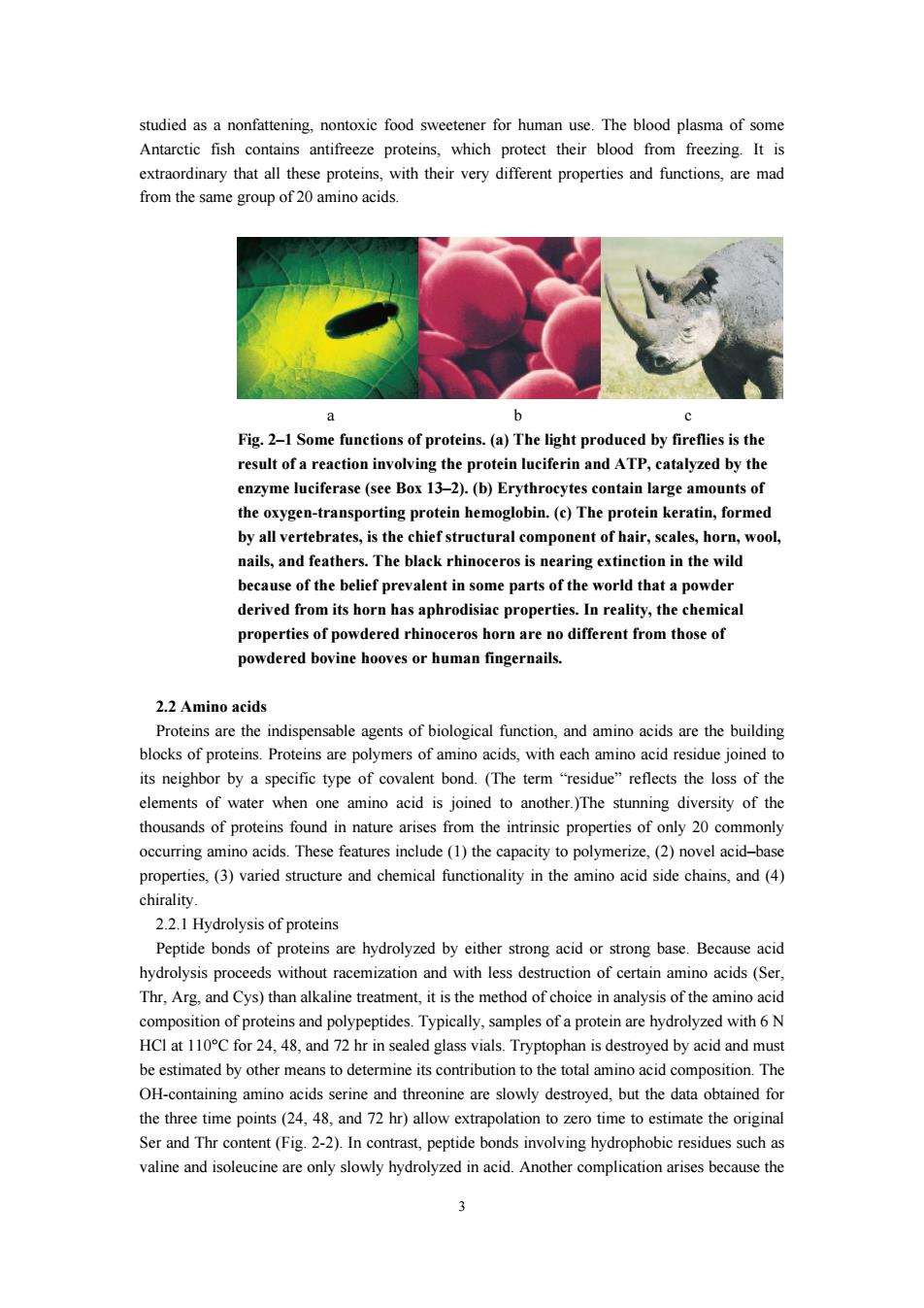
studied as a nonfattening.nontoxic food sweetener for human use.The blood plasma of some Antarctic fish contains antifreeze proteins which protect their blood from freezing Itis extraordinary that all these proteins,with their very different properties and functions,are ma from the same group of 20 amino acids Fig.2-1 Some functions of proteins.(a)The light produced by fireflies is th result of a reaction involving the protein luciferin and ATP,catalyzed by the enzyme luciferase (see Box 13-2).(b)Erythrocytes contain large amounts of the oxygen-transporting protein hemoglobin.(c)The protein keratin.formed by all vertebrates,is the chief structural component of hair,sales,orn,wool ails,and feath s.The black rhinoceros is nearing extinetion in the because of the belief prevalent in some parts of the world that a powder derived from its horn has aphrodisiac properties.In reality,the chemical properties of powdered rhinoceros horn are no different from thoseof vdered bovine hooves or human fingernails. 2.2 Amino acid Proteins are the indispensable agents of biological function,and amino acids are the building blocks of proteins.Proteins are polymers of amino acids.with each amino acid residue joined to its neighbor by a specific type of covalent bond.(The term"residue"reflects the loss of the amino acid is joined to another.)The stunning diversity of the found in nature arises from the intrinsic properties of nly 20 commonl occurring amino acids.These features include(1)the capacity to polymerize,(2)novel acid-base properties,(3)varied structure and chemical functionality in the amino acid side chains,and (4) chirality. 2.2.1 Hydrolysis of proteins Peptide bonds of proteinsare hydrolyzed by either strongacid or strong base.Because acid hydrolysis proceeds without racemization and with less destrction of certain amino acids(Se Thr.Arg.and Cys)than alkaline treatment.it is the method of choice in analysis of the amino acid composition of proteins and polypeptides.Typically,samples of a protein are hydrolyzed with 6N HCI at 110C for 24.48.and 72 hr in sealed glass vials.Tryptophan is destroved by acid and must total amin mposition.The H-oniningnnnrre swy destroyed,but the the three time points(24,48,and 72 hr)allow extrapolation to zero time to estimate the original Ser and Thr content(Fig.2-2).In contrast,peptide bonds involving hydrophobic residues such as valine and isoleucine are only slowly hydrolyzed in acid.Another complication arises because the
3 studied as a nonfattening, nontoxic food sweetener for human use. The blood plasma of some Antarctic fish contains antifreeze proteins, which protect their blood from freezing. It is extraordinary that all these proteins, with their very different properties and functions, are mad from the same group of 20 amino acids. a b c Fig. 2–1 Some functions of proteins. (a) The light produced by fireflies is the result of a reaction involving the protein luciferin and ATP, catalyzed by the enzyme luciferase (see Box 13–2). (b) Erythrocytes contain large amounts of the oxygen-transporting protein hemoglobin. (c) The protein keratin, formed by all vertebrates, is the chief structural component of hair, scales, horn, wool, nails, and feathers. The black rhinoceros is nearing extinction in the wild because of the belief prevalent in some parts of the world that a powder derived from its horn has aphrodisiac properties. In reality, the chemical properties of powdered rhinoceros horn are no different from those of powdered bovine hooves or human fingernails. 2.2 Amino acids Proteins are the indispensable agents of biological function, and amino acids are the building blocks of proteins. Proteins are polymers of amino acids, with each amino acid residue joined to its neighbor by a specific type of covalent bond. (The term “residue” reflects the loss of the elements of water when one amino acid is joined to another.)The stunning diversity of the thousands of proteins found in nature arises from the intrinsic properties of only 20 commonly occurring amino acids. These features include (1) the capacity to polymerize, (2) novel acid–base properties, (3) varied structure and chemical functionality in the amino acid side chains, and (4) chirality. 2.2.1 Hydrolysis of proteins Peptide bonds of proteins are hydrolyzed by either strong acid or strong base. Because acid hydrolysis proceeds without racemization and with less destruction of certain amino acids (Ser, Thr, Arg, and Cys) than alkaline treatment, it is the method of choice in analysis of the amino acid composition of proteins and polypeptides. Typically, samples of a protein are hydrolyzed with 6 N HCl at 110°C for 24, 48, and 72 hr in sealed glass vials. Tryptophan is destroyed by acid and must be estimated by other means to determine its contribution to the total amino acid composition. The OH-containing amino acids serine and threonine are slowly destroyed, but the data obtained for the three time points (24, 48, and 72 hr) allow extrapolation to zero time to estimate the original Ser and Thr content (Fig. 2-2). In contrast, peptide bonds involving hydrophobic residues such as valine and isoleucine are only slowly hydrolyzed in acid. Another complication arises because the